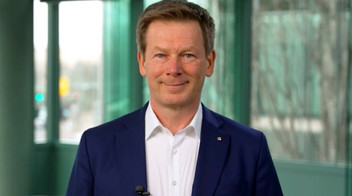Markets and strategy
Demand for passenger transport is again high. The performance development in freight transport is impacted, among other things, by the economic situation. For the coming years, a further increasing demand for capacity is expected due to growth in demand for freight transport and a significantly increased traffic volume in passenger transport. General modernizations in the high-performance network will lead to short-term capacity shortages, but will nevertheless support growth over the long term.
By developing infrastructure in line with customer and market requirements, we want to enable the entire rail transport sector to take advantage of growth potential. The Strong Rail strategy incorporates DB InfraGO’s key strategic issues with this target in mind.
As a capacity manager, the Track business area intends to create the infrastructural and operational conditions for realizing the Strong Rail strategy. The objective is to operate a highly condensed, highly interconnected and high-performing network that will be ensured through systematic modernization, targeted upgrading and the prospective expansion of network capacity. This is also supported by the targeted implementation of Digital Rail for Germany ( DSD), the improvement of the organization’s performance capability and improved use and availability of existing capacities.
The aim for passenger transport is to double volume sold. Stations play a central role in this. They are the gateways to sustainable mobility on the rails. The Passenger Stations business area has set itself the strategic goal of making a social contribution to ensure all people in Germany are connected to a livable country.
To achieve the objectives in both business areas, DB InfraGO’s strategy essentially comprises four strategic areas of expansion:
- More robust: Through the renewal, digitalization and expansion of the infrastructure in line with requirements, we aim to increase network capacity in corridors and hubs in order to eliminate existing bottlenecks and to be able to provide the necessary capacity for service expansions. This counteracts the overloading and aging of the infrastructure and enables greater reliability and growth on the rails. The central element of the strategy is the development of a high-performance network which aims to improve the customer experience and ability to plan the capital expenditure measures, as well as boosting the reliability and performance of the infrastructure. The stated goal is to transform the highly utilized network into a high-performance network by 2030 through a general modernization of the most important rail corridors and thus make it a bedrock of stability for the rail system. There are several new and crucial elements here. For example, the construction work is to be combined in order to keep a line almost completely free of construction for many years after a single closure. In order to minimize the capacity restrictions, highly condensed and efficient construction procedures are implemented. We are focusing on prevention to ensure that the lines remain reliable after the modernization. The aim is to detect and eliminate disruptions even before they occur or cause an impairment to operation. In addition, the overall performance capability of the high-performance network is to be ensured by improving reliability and capacity at the hubs. As part of the modernization work, preliminary work will already be carried out, where possible, for the implementation of Digital Rail for Germany and the lines will get prepared for electronic/digital interlockings and Digital Rail for Germany. In addition to upgrading the particularly highly utilized lines in the high-performance network, the maintenance of the entire infrastructure is the basis for the high-performance capability of rail transport. Accordingly, as a basis the other parts of the network next to the high-performance network as well must remain or become to be operated efficiently. Furthermore, we will expand our infrastructure in a targeted way through new construction and expansion, as well as through line electrification, thus creating the necessary capacity for implementing Germany in sync. In the Passenger Stations business area, we are continuously improving the perceptible quality of our railway stations and their surroundings with unified production standards. Standardizing and increasing digitalization streamlines processes, optimizes maintenance measures and enables a transition to status and demand-oriented production concepts. We are investing in new construction projects and developing future-oriented capacity concepts to ensure our infrastructure is robust, attractive and secure in order to help achieve the desired shift in the mode of transport and support the increase in passenger numbers.
- More powerful: We are implementing various measures, including lean excellence and digitalization, which shall lay the foundations for effective and stable processes oriented towards the customer and enable an efficient organization. As part of the lean excellence transformation, we will establish a lean-thinking and lean-acting organization that is characterized by developed cultural aspects and a pronounced lean mentality among all employees. This lays the foundations for excellent performance and continuous improvement of processes. Our processes begin with customers and their requirements, and we develop effective solutions to increase customer satisfaction. The introduction of comprehensive performance management for all organizational units creates transparency about relevant key figures and enables clear control along our customer-oriented processes. As part of our performance management development, we are focusing on leadership excellence. This will help strengthen the leadership performance of executives and thus also sustainably improve process performance and employee satisfaction.
- More modern: DB InfraGO performs supporting tasks for issues concerning Germany in sync and European corridors. Improving robustness and therefore increasing capacity are key prerequisites for this. We would also like to increase the quality of our guests’ stays at our stations. We intend to integrate stations even more comprehensively and effectively into people’s everyday lives and make their stays attractive by providing relevant offers. We are optimizing our passenger information system and further developing our guidance systems so that passengers and guests from the local neighborhood can find their way around as quickly as possible. We are further expanding WiFi at stations. Our Smart City initiative is making stations and their surroundings more livable. We are developing innovative usage concepts for stations, rethinking station neighborhoods and ensuring interlinked, sustainable mobility. This includes new services such as smart lockers, options for remote working at stations, attractive forecourt design, including shared spaces for onward travel, and micro-hubs for city logistics.
- Greener: Key levers in infrastructure on the path to a climate-neutral future include the further electrification of lines – including innovative approaches such as overhead wire islands and the redesign of our own production processes. We are focusing on sustainable vegetation management, environmental protection measures, resource conservation through initiatives to promote circular economy approaches, and noise reduction. In addition, measures are being implemented to reduce greenhouse gas emissions, for example in building management. In order to improve the environmental footprint of our stations, we aim to reduce CO₂e emissions, make our use of materials greener in line with the principles of the circular economy, and develop biodiversity at our stations. In the Passenger Stations business area, we intend to reduce our absolute Scope 1 and Scope 2 emissions by 81% by 2025 compared to 2019. One way to achieve this is by using 100% eco-power and by making our heat consumption greener. We are also consistently reducing our energy consumption through energy efficiency measures such as LED exchange. We are also focusing on new concepts for onward mobility connections, ranging from digital services such as the DB Rad+ app to bicycle repair service Radfix through to the expansion of the Bike+Ride cycle parking spaces. In 2023, new parking spaces were built at about 80 stations. We are also testing a sustainable construction approach called “The Little Station” (Der Kleine Bahnhof). Through the BALIN research project, we are also researching the possible effects of station lighting on insects. Together with the French state-owned railway SNCF, we have determined the criteria that define a sustainable station, from reducing energy consumption to accessibility of the infrastructure in the “Sustainable Railway Station” charter.


